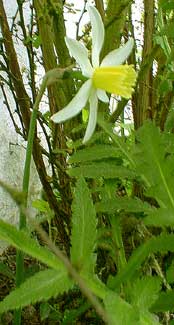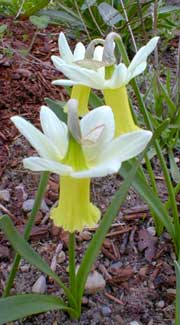
'Jack Snipe'
Miniature Daffodils
aka Dwarf Narcissi
"Though many a flower in the wood is waking,
The daffodil is our doorside queen;
She pushes upward the sword already,
To spot with sunshine the early green."
- William Cullen Bryant,
Invitation to the Country, 1864
Invitation to the Country, 1864
Among bulbs, I prefer those with somewhat subtle flowering that fit well into a naturalistic woodland setting, such as the little checkered lily (Fritillaria meleagris) or the smallest camas flower (Camassia quamash) or dogtooth lilies (Erythronium sp.). By comparison, the typical huge overt daffodils is overdoing it, in small gardens like ours at least.
 But varieties of miniature daffodils have all the beauty of full-sized daffodils with the additional trait of staying eight inches to a foot tall give or take, providing bright splashes of yellow, white, & occasionally peach or orange, without being garish & overbearing. They're still not exactly subtle, but being small they are not there to draw attention away from everything else.
But varieties of miniature daffodils have all the beauty of full-sized daffodils with the additional trait of staying eight inches to a foot tall give or take, providing bright splashes of yellow, white, & occasionally peach or orange, without being garish & overbearing. They're still not exactly subtle, but being small they are not there to draw attention away from everything else.The pure species Narcissus cyclamineus is native of Portugal. In its species form, as opposed to its many cultivars, it was once very common in gardens, but is today rare, the cultivars having displaced it in popularity.
We planted two cultivars of N. cyclamineus at the foot of a Japanese Red Barberry in 2001. Shown in the April 2003 photo atop this page is 'Jack Snipe.' This has slender moderately reflexed creamy-white petals with a long bright yellow-orange cup. Planted with it at the foot of the same Barberry, we also placed 'Tete a Tete' which has a pale yellow trumpet with paler yellow petals. These two looked wonderful together.
Because of the rapid growth of a nearby cherry tree, & of a lot of shrubs, the area became increasingly shaded, & these two daffodils were unable to naturalize with insufficient sun to recharge the bulbs. In autumn 2003 I lifted 'Jack Snipe' & 'Tete a Tete' & moved them to roadside sun-garden. A few of the 'Tete-a-Tete' bounced back, & other 'Tete-a-Tete' bulbs were added that same year. But the 'Jack Snipes' did not recover their strength & the bulbs from 2001 had faded into non-existance. The next autumn, in autumn 2004, I added another half-dozen 'Jack Snipe' bulbs to the roadside garden, on a ledge near the foot of a tall fountaining Black Twinberry.
The first photo shows the original Jack Snipe which in the overly shaded original location became a bit taller than on average for them, the flowers faced rigidly forward, & the white petals were extremely thin. The second planting resulted in quite a different appearance of Jack Snipes that were extremely short, kept their trumpets strongly goosenecked down, & had fatter white petals. I don't think shade alone accounts for how different the earlier group had been, & they must just be very different strains from two sources. It makes me really sorry the earlier ones ended up in too much shade only to weaken in two years & finally disappear, as I liked the look of those even better than the ones we have now.
'Jack Snipe' was developed by hybridizer M. P. Williams. It has become one of the more standard dwarf offerings because of its hardiness, ease of naturalizing, & its beauty, for which reasons it additionally received the Award of Garden Merit from the Royal Horticultural Society.
Although cultivars of C. cyclameneus are not usually among the most cold-hardy of daffodils, 'Jack Snipe' is hardier than average, & the whole cyclameneus group thrives in temperate climates such as ours, in sun to bright shade. And as I found out, they bloom very well in deeper shade too, but only for one or two years before they're worn out.
When these are finished blooming they can be fed a high potash fertilizer which will help increase its vigor for the next year. As with all daffodils, the leaves should be allowed to die back naturally. For the especially tidy gardener they can be trimmed off when they go brown, but not sooner.
Most of the time these cultivars have only one flower per stem, but occasionally a vigorous bulb will produce more. Their blooms face downward in a pendulous position & they rarely exceed eight inches tall, hence much smaller than N. jonquilla cultivars which are also regarded as miniatures but usually exceed a foot of height.
In spring they love moisture including positions near to ponds, yet late winter & early spring rains are always sufficient here on Puget Sound, so that they are completely no-maintenance. They are even a little drought hardy if need be, though stronger if kept moist. In summer & autumn dormancy, though, they should be left a little dry, or may rot. Mainly they're very reliable at perennializing so long as they have enough sun to recharge for another year.
These are among the easiest of easy bulbs to grow & never fail to please. They can be as happy container-grown as in the ground. The flowers strongly want to face the sun, so if there is shadow or a wall at their rear they will always face the viewer, but if placed along a picket fence, depending on where the sun is at, they may face out of the yard.